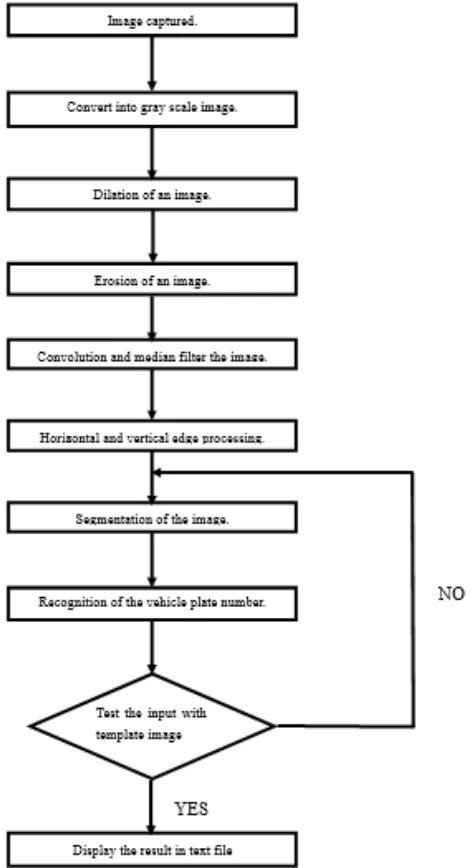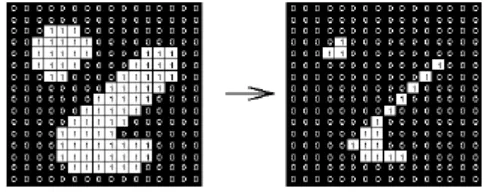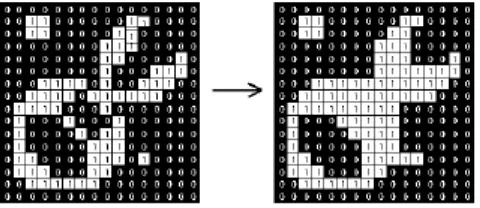UNIVERSITI TEKNIKAL MALAYSIA MELAKA
AUTOMATIC VEHICLE RECOGNITION USING
MORPHOLOGICAL AND TEMPLATE MATCHING
TECHNIQUE
This report is submitted in accordance with the requirement of the Universiti Teknikal Malaysia Melaka (UTeM) for the Bachelor’s Degree in Computer
Engineering Technology (Computer Systems) with Honours.
by
KHAIRUL IKHWAN BIN SAMSUDIN B071410514
950909-04-5091
UNIVERSITI TEKNIKAL MALAYSIA MELAKA
BORANG PENGESAHAN STATUS LAPORAN PROJEK SARJANA MUDA
TAJUK: AUTOMATIC VEHICLE RECOGNITION USING MORPHOLOGICAL AND TEMPLATE MATCHING TECHNIQUE
SESI PENGAJIAN: 2017/18 Semester 2
Saya KHAIRUL IKHWAN BIN SAMSUDIN
mengaku membenarkan Laporan PSM ini disimpan di Perpustakaan Universiti
Teknikal Malaysia Melaka (UTeM) dengan syarat-syarat kegunaan seperti berikut:
1. Laporan PSM adalah hak milik Universiti Teknikal Malaysia Melaka dan penulis. 2. Perpustakaan Universiti Teknikal Malaysia Melaka dibenarkan membuat salinan
untuk tujuan pengajian sahaja dengan izin penulis.
3. Perpustakaan dibenarkan membuat salinan laporan PSM ini sebagai bahan pertukaran antara institusi pengajian tinggi.
4. **Sila tandakan ( )
SULIT
TERHAD
TIDAK TERHAD
(Mengandungi maklumat yang berdarjah keselamatan atau kepentingan Malaysia sebagaimana yang termaktub dalam AKTA RAHSIA RASMI 1972)
(Mengandungi maklumat TERHAD yang telah ditentukan oleh organisasi/badan di mana penyelidikan
dijalankan)
Alamat Tetap:
Tarikh: ________________________
Disahkan oleh:
Cop Rasmi:
Tarikh: _______________________ ** Jika Laporan PSM ini SULIT atau TERHAD, sila lampirkan surat daripada pihak berkuasa/organisasi
i
DECLARATION
I hereby, declared this report entitled “Automatic Vehicle Recognition Using Morphological and Template Matching Technique” is the results of my own
research except as cited in references.
Signature : ……….
Author’s Name : ………
ii
APPROVAL
This report is submitted to the Faculty of Engineering Technology of UTeM as a partial fulfillment of the requirements for the degree of Bachelor’s Degree in
Computer Engineering Technology (Computer Systems) with Honours. The
member of the supervisory is as follow:
iii
ABSTRAK
iv
ABSTRACT
v
DEDICATION
To my beloved parents, Samsudin Bin Kassim and Norizan Binti Md Sin who always support and inspiring me during process of completing this project.
To my respected supervisor, Mr Rosman Bin Abd Rahim who taught me from the start of this project, from I have zero knowledge for this project until I can finish
this project on time.
vi
ACKNOWLEDGEMENT
vii
TABLE OF CONTENT
Declaration i
Approval ii
Abstrak iii Abstract iv Dedication v
Acknowledgement vi
Table of Content vii List of Tables x
List of Figures xi
List Abbreviations, Symbols and Nomenclatures xiii
CHAPTER 1: INTRODUCTION 1
1.1 Introduction 1
1.2 Background 1
1.3 Problem Statement 2
1.4 Objective 3
1.5 Scope 3
1.6 Chapter Summary 5
CHAPTER 2: LITERATURE REVIEW 6
2.1 Overview 6
2.2 Introduction 6
2.3 Pre-Processing Method 7
2.4 Morphological Process 8
2.5 Methods used for Character Recognition 9
2.6 Comparison between the Methods Used 11
viii
CHAPTER 3: METHODOLOGY 14
3.1 Introduction 14
3.2 Work Plan 14
3.3 Flowchart of the System 15
3.4 MATLAB software 16
3.5 Pre-Processing Input Image 17
3.5.1 Conversion to Grayscale 17
3.5.2 Binarization 17
3.5.3 Median Filter 19
3.6 Morphological Process 21
3.6.1 Erosion 21
3.6.2 Dilation 23
3.7 Image Segmentation and Extraction 24
3.8 Recognition of Plate Number 26
3.9 Creating a GUI in MATLAB 29
3.10 Conclusion 30
CHAPTER 4:RESULT & DISCUSSION 31
4.0 Introduction 31
4.1 Project Flow and Description of the Source Code 32
4.1.1 Start 32
4.1.2 Input Image 32
4.1.3 Extraction of the Image and Morphological Process 33
4.1.4 Segmentation of the Image 40
4.1.5 Localization and Recognition 42
ix
4.2.1 Analysis of the Character Recognition 47
4.3 Factors that Affect the Findings 49
4.3.1 Distance and Positon of the Image Taken 49
4.3.2 Time of the Image Taken 50
4.3.3 Type of the Plate Number Taken 51
4.4 Accuracy Percentage of the System 52
4.4.1 Accuracy of all Characters Tested 52
4.5 Discussion 53
4.6 Conclusion 54
CHAPTER 5: CONCLUSION & FUTURE WORK 55
5.1 Conclusion of the Whole Project 55
5.2 Limitations 56
5.3 Future Work and Recommendations 56
References 56
Appendices 57
Appendix A – PROJECT SOURCE CODE 57
x
LIST OF TABLES
2.1
4.1 4.2 4.3 4.4
Summary of chapter 2
Data Samples Result
Result for Distance and Position of the Image Taken Result for Image Taken at Different Time
Result when Comparing Different Type of Plate Number
12
xi
LIST OF FIGURES
1.1 Flowchart of the project 4
2.1 Example of erosion process 8
2.2 Example of dilation process 8
2.3 Example of image opening 9
2.4 Example of image closing 9
2.5 Example of database template 10 2.6 Result when use template matching technique 11
3.1 Flowchart of the project 15 15
3.2 Formula for conversion image to grayscale 17
3.3 Image that had been grayscale 18
3.4 Image after threshold of 139 being applied 18
3.5 Image of adaptive threshold of 139 19
3.6 Example median filtering using 3 x 3 sampling window 20 3.7 Extending border values outside with values at boundary 20 3.8 Extending border values outside with 0s 21
3.9 A 3×3 square structuring element 22
3.10 Dilation of a binary image 24
3.11 Horizontal edge processing 25
3.12 Vertical edge processing 26
3.13 Example for plate number in Russia 27
3.14 Example for plate number in Saudi Arabia 28
3.15 Example of database for alphabet 28
3.16 Example of database for numbers 29
3.17 Example of GUI in MATLAB software 30
4.1 GUI of the Project 32
4.2 Input Image Algorithm 32
xii
4.4 Grayscale Image Algorithm 34
4.5 Example of Grayscale Image 34
4.6 Binary Image Algorithm 35
4.7 Example of a Binary Image 36
4.8 Median Filter, Dilation and Erosion Algorithm 37 4.9 Convolution, Flood Fill and Image Cropping Algorithm 38 4.10 Example of the Output Image after Morphological Process 38
4.11 Smearing Algorithm 39
4.12 Example of the Output Image after Smearing Process 39
4.13 Segmentation of the Character Algorithm 41
4.14 Example of the Output Image after Segmentation Process 41
4.15 Localization Algorithm 42
4.16 Recognition of the Characters Algorithm 43
4.17 Example of the Output Image after the Recognition Process 43
4.18 Graph of Accuracy Rate versus Frequency 45
4.19 Overall Accuracy Percentage 46
4.20 Image of a Successful Result 47
4.21 Image of a Failed Result 48
4.22 Output Result when Taking Image with 1.5 meter and Not
Straight 49
4.23 Result when Taking Image at Night 50
4.24 Result when Taking Image of Two-Line Plate Number 51
xiii
LIST OF ABBREVIATIONS, SYMBOLS AND
NOMENCLATURE
ALPR - Automatic License Plate Recognition ANN - Artificial Neural Network
ANPR - Automatic Number Plate Recognition FFNN - Feed Forward Neural Network
GUI - Graphical User Interface
GUIDE - Graphical User Interface Development Environment MATLAB - Matrix Laboratory
1 1.0 Introduction
This chapter presents the overview for overall description for this project. Hence, this chapter also provides the brief information of the background of project, problem statement, objectives and scope.
1.1 Background
Nowadays, so much criminal takes place everywhere by using a vehicle. This is because it is easy for them to run away right after doing the crime. Usually, it is difficult for people around the crime scene area to recognize the vehicle plate number.
Plate number is vehicle registration plate and it will vary for every vehicle. Plate number is a unique official identification number for every vehicles and must be registered with the official agency. Plate number is unique because it is
combination of some letters and numbers. There is no vehicle with same plate number. Every vehicle will have different plate number and each country have different format to assign the plate number. For example, in Malaysia, the most-right letter will represent where the vehicle being registered. If the vehicle register in Selangor and Melaka, the plate number will start from letter ‘B’ and ‘M’
respectively. The vehicle plate number usually placed in a front and rear of a vehicle
INTRODUCTION
2 so it is easy to detect or see the plate number especially when there is a crime
involving a vehicle or hit-and-run by a vehicle.
The only way and maybe the best way to recognize the plate number are by installing the security camera around the high possibility crime scene area. Other than it can help monitoring the area, it also can help in detecting the plate number or the criminal body gesture. Hence, this program is made to identifying the plate number after it being captured by the security camera. There is some importance of this system and one of it is can reduces the crime rate in the using area because when it captured the image and after system have done, the output result will give the right plate number. So, it will not take time to identify the car that involves in the crime. Next, the system can be used in a high school or university where the student is prohibited to use a car. So, the systems will detect all cars that passing through the main gate and it will detect if any students break the rule.
In this project, the software we want to use is MATLAB software. This is because the software will fulfill all the requirement needed including the pre-processing part. The program also can run the mathematical operation, correlation function which is used in this project to detect the possibility of the plate number. Correlation function will be used in order to correlate between the input image and the template image.
By the end of this project, the system will recognize the vehicle plate number that being tested and will give about 70% of accuracy rate.
1.2 Problem Statement
The problems are for an automatic recognition of vehicle plate number without human supervision for solving many problems such as:
3 b. A crime happened in a quiet place.
c. Smuggling of cars.
d. Usage of cars in terrorist attacks or illegal activities. e. In speed trap.
f. Parking entrance.
1.3 Objectives
The objectives of this project are:
a. To develop a vehicle plate recognition by using morphological and template matching technique.
b. To apply the programming knowledge by using the MATLAB software and Simulink in order to compute the project.
c. To analyze whether the performance and the accuracy of the technique used in the system can efficiently recognize the vehicle plate number.
1.4 Scope
4 will be compare to the template image in order to get the output. The figure below shows the framework for the system that will be develop in this project from the captured of image until the output that will be stored in the text file.
5
1.5 Chapter Summary
This report is basically the discussion of the how the project will be done which is includes the morphological process and template matching technique. The morphological process and the technique will be combine in order to gain the right output. In chapter one (1), the introduction of the project was explained which includes the background, objectives, problem statement and scope of the work. The second chapter will discuss on the literature review and the related review. This will include the discussion about the accuracy when another technique and process used. Besides, it will also discuss on how to overcome the problem from other technique. Chapter three will discuss about the methodology used to complete the project. So, the software used and the features in the software will be discuss precisely. Next, in chapter four, we will focus on the result obtain and if the result cannot be obtained and will discussing the problem on why it cannot produce the right output. In last chapter, the recommendations and conclusions of the project will take place.
6 2.1 Overview
This chapter will cover about the past research about the automatic vehicle plate recognition and will discussed about the methods used and the result that obtained from past researches. From the articles that have been go through, there are many different methods used and it is more about recognition of the number plate. For the morphological part, mostly research used the same technique which is pre-processing process from conversion of the image, enlighten the image by using erosion and dilation process and using median filter to remove noise in the input image.
2.2 Introduction
Nowadays, in order to minimize the human activity there are many technology or systems being invented and one of them is automatic vehicle plate recognition and in the last few years, it has become an important subject of study. Not only, it can prevent a crime like smuggling of cars, it also can improve the security of a parking lots where it will alert to violations of permitted, time limited or scofflaw vehicles. By using this system, the management mainly can detect if any wrongdoings by any vehicle driver and this will help to reduce the crime activity in that area. Not just that, this system also used by police forces to check whether the vehicle is registered or not and whether it is involved in any crime or wrongdoings
7 such as clone cars and stolen cars. Even though it can capture the image and reduce the crime, it also fears the citizens if the image taken is misidentification. It also used by police forces as a method of electronic toll collection on pay-per-use roads and monitoring traffic activity, such as red light adherence in an intersection (Badr et al., 2011).
Automatic vehicle plate recognition will recognize the correct plate number if and only if the pre-processing process had done successfully because if the input image still in RGB, it cannot undergo enlighten process like erosion. Then, the segmentation also the important part because if the area of interest taken is not what it should be, the output result will not produce the correct answer because the technique used need to match the input image with the template image.
There are many techniques that can produce the correct output but all the techniques need the clearly image that already enlighten and already remove the noise in the image.
2.3 Pre-Processing Method
Pre-processing is the main and important step before move to the next steps. To recognize the input image using template matching technique, the image need to convert first or else it will not recognize the image. Same goes to erosion and dilation process it will process the only if the image is grayscale or binary image and will undergo the process if the image is still in RGB.
8 highlight edges in order to improve the quality of the image (Munuo, 2014). To fill the holes in the binary images, use the imfill function.
2.4 Morphological Process
[image:23.595.196.443.514.611.2]Based on Vandini (2014) in their research about automatic license plate recognition, the input image must have a background of yellow and they have to find the regions where contains the intensity of R(Red), G(Green) and B(Blue) that corresponding to the yellow colour. The nearest value of the arena is calculated and considering arena as black and then depends on the RGB index, the plate number is binarized. Comparing to research from Mitra (2014), after the input image has converted into a binary image, the erosion and dilation process carried out. This process is often used to remove irrelevant details from binary images and dilation is used to fill the gaps or hole(Mitra, 2014). Not just that, the research also make image opening and image closing. Opening generally smooth the contour of an object, breaks narrow isthmuses, and eliminates thin protrusions (Mitra, 2014) while image closing tends to smooth sections of contours but as opposed to opening, it fuses narrow breaks and fills gaps in the contour (Mitra, 2014). Following are the example for erosion, dilation, image opening and image closing:
9 Figure 2.2: Example of dilation process
Figure 2.3: Example of image opening
Figure 2.4: Example of image closing
2.5 Methods used for Character Recognition
There are many methods for recognize the plate number after the plate number being pre-processed and segmented. According to Munuo (2014), the
[image:24.595.201.441.362.466.2]

